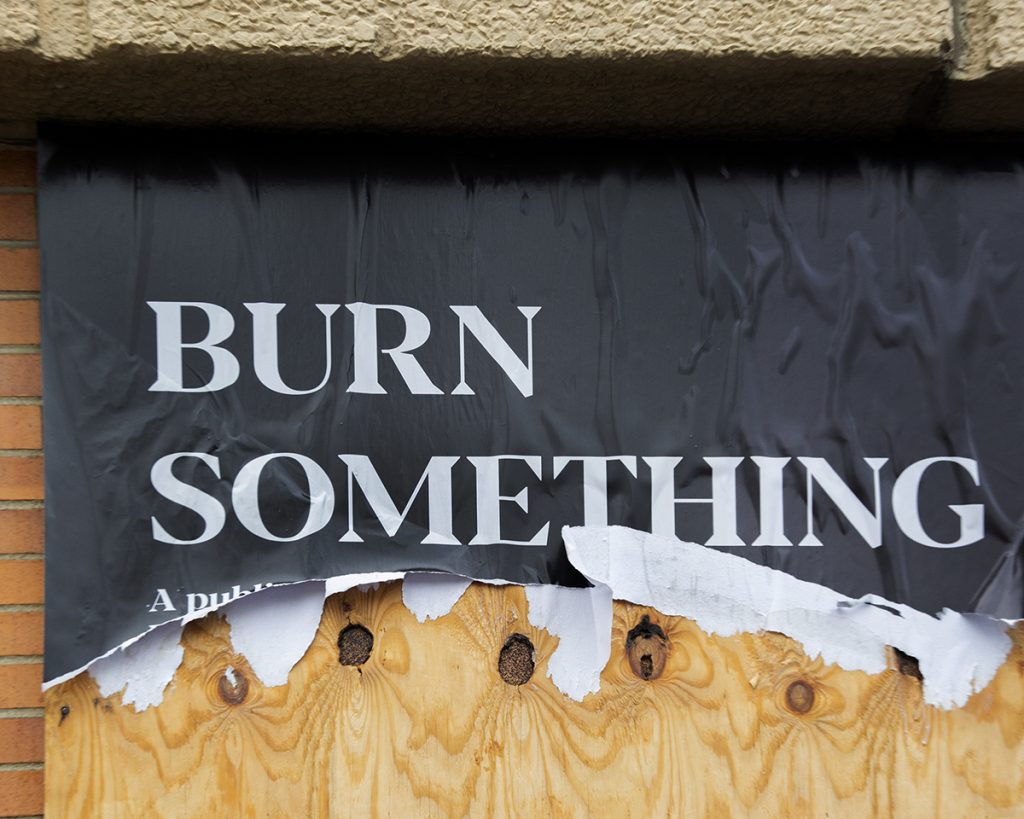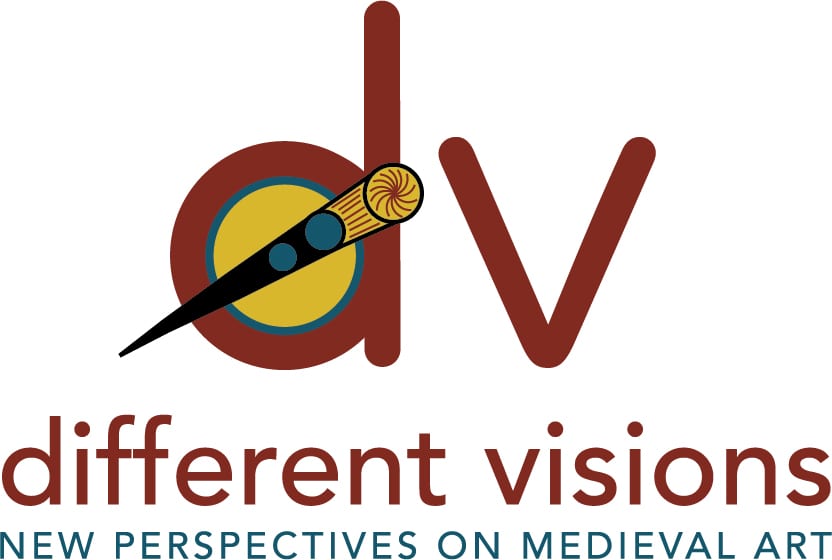
Fig. 1
In this guest post, Gabby Coll reflects on her work co-curating the public art exhibit Burn Something.
If nothing else, living and working in the year 2020 has taught me to take chances. In 2019, my collaborator, Adrienne Doyle, and I were accepted into the inaugural cohort of the Emerging Curators Institute (ECI) – a one-of-a-kind program created to freak the form of curation and offer material, educational, and financial support for emerging curators in the Twin Cities. Obviously, we never could have known what was going to happen in the year since that acceptance, but from the beginning, I did have a sense that something meaningful was underway.
Adrienne is the kind of person that exudes ease and grace. That’s one of the reasons why, when the idea of collaborating on an application for the Emerging Curators Institute was proposed, I immediately said yes. She barely told me about Burn Something Zine and I was in. Burn Something was a submission-based, queer and trans-inclusive media project featuring words and art by femme and gender non-conforming (GNC) people of color in the Twin Cities, which Adrienne produced between 2014 and 2016. In 2019, she and I had known each other for about a year, as coworkers at Juxtaposition Arts, a youth-focused art education and employment non-profit located in North Minneapolis – though we soon realized that we had gone to middle school together many years ago. In that moment, it felt like we were supposed to be in that room, in the living room of her apartment, uncovering a stack of old zines together, pondering the next iteration of this project.

So much about our world, and the presentation of the Burn Something exhibition, has changed within the span of a year. The project was collaboratively conceived of, building upon the same concepts, themes, and intention of the originally published Burn Something zines and shifting the focus to visual art in an exhibition setting, rather than a printed zine. Somehow, though, everything seemed to align itself amidst the chaos. Our exhibition was originally set to show at Modus Locus in south Minneapolis in May 2020. We were hesitant to exhibit in a white-walled space; we searched for a more DIY, inclusive, and intimate format in the spirit of zine-making and the content of the exhibition. We wanted to create community and an invitation to engage with the selected work in a no-pressure environment. But Modus Locus was a great non-traditional compromise, and we admired the work they were a part of in the arts community in the Twin Cities. In March, the city shut down due to Covid-19, and all of our plans were put on indefinite hold. In May, George Floyd was murdered not far from where Adrienne and I both live and work. We were tired and overwhelmed, caught between a global pandemic that kept us from holding space together, and an ongoing pandemic of racial inequality coming to a violent climax in our very city. Minneapolis burned for what seemed like months.
The ECI exists to flip the current understanding and expectations around curating and the mostly unequal access to educational opportunities in this field. The ECI offers a free, intensive educational experience, along with a stipend and a show budget. I don’t know about you, but I have never come across any programs like this, especially not ones that don’t require a(n expensive and inaccessible) Master’s or PhD. That’s a problem. And it’s one of the problems the first iteration of Burn Something Zine was trying to address, really. From a practical standpoint, Burn Something Zine exists in response to the systemic undermining of communities of color and the erasure of queer bodies in modern lived experience. Calling upon a decades-long history of zine-making – or centuries-long depending on whom you ask – Burn Something carved itself a pocket of space for Black and POCI queer creatives to make more, share more, and be in space together. The ECI, in turn, aims to shift the curatorial field towards a more radically equitable framework.
Once we got our bearings over the summer, we realized the end of the Covid-19 pandemic was not in sight, but we wanted to keep feeding the fire we felt in this project. And then something clicked within the chaos. Adrienne had the brilliant idea to transform the exhibition to an outdoor public art installation. We got in touch with artists from Creatives After Curfew, and they provided a space: the boarded-up windows of the new Family Partnerships building under construction at the intersection of East Lake Street and Bloomington Avenue South. Our exhibition’s home now became a completely publicly accessible, larger-than-life experience. Within three weeks, we adjusted our plans, adapted our format, and wrote new exhibition materials. We decided to select one piece of work from each of the six artists we had originally accepted from an open call for submissions in December 2019; originally, each artist was to show several pieces in the exhibition, all of the works responding to five themes threaded throughout the original Burn Something zines. We got high-res images of each of the newly-selected pieces, blew them up to 4’ x 8’, and fast-tracked printing on photo paper to install on each of the eight window boards (shout-out to Arts District Image Works for the incredibly fast turnaround). Suddenly, we had an exhibition aptly titled “Burn Something” that responded directly to what was happening so acutely in this moment. The work decorated boards protecting local businesses from the chaos bursting forth from decades – centuries, all of history – of inequality, violence, and oppression. This is not a new crisis, but rather a tragically ongoing one that just happened to set fire to our city in the summer of 2020.

Emotionally, it feels too intimate to reduce a year of deep relationship-building and learning into a few paragraphs. The artists and their work presented in this exhibition respond to five themes threaded through the original six Burn Something publications. Seeing their processes and getting a peek into their curious minds has inspired in me a renewed sense of awe about the possibilities in this kind of work. All of these artists approach these thematic threads with depth, tenderness, and care and I continue to be shaken by the power of creative expression in the act of narrative-claiming. In working on this project with Adrienne through the ECI and with the artists we selected for the exhibition, I have increasingly come to understand the radical potential that lies in acts of discovery, creation, and commune. I’ve found liberation and joy in making, connecting, and uncovering threads between people, ideas, concepts, and spaces. It is through these connections and ideas that we start to uncover grains of truth.

White supremacy has taught me to take up less space. It has told me not to trust my intuition. To question less. Capitalism has taught me my only value is my productivity. That taking time to rest, to find connection and self-actualization, and the accompanying joy, are the enemy. Much of my education has been steeped in stifling, Euro- and Anglo-centric curricula where I was not taught the critical thinking skills to fully define the discomfort I felt in those environments. In the context of many lies, unpacking and understanding one’s own identity and privileges is humbling, often painful work. This project has allowed me to critically examine the ways in which I carry privilege, and the way in which I also carry trauma, much of which I have not had the space to fully address yet. This process, in itself, is a privilege.
The point is: take that chance. If what you need to thrive within our existing institutions doesn’t exist, create it. The structures currently in place aren’t meant for anyone who isn’t white, male, highly educated within predetermined academic expectations, and with access to material wealth and resources. So, if you are someone for whom these institutions weren’t created to accommodate: trust your intuition, trust the things that give you the opportunity to take up space and create something new, and question who or what is guiding your decision-making. Take the chances, because without bold action, the changes we need to make to ensure our survival won’t happen. If all else fails, burn it down and start again.
As Gloria Anzaldúa writes: “…we intimately know the origins of oppression; it brewed in our beds, tables, and streets; screaming out in anger is a necessary stage in our evolution into freedom, but do we have to dwell forever on that piece of terrain, forever stuck in the middle of that bridge? This land of thorns is not habitable. We carry this bridge inside us, the struggle, the movement toward liberation.”
I invite you to walk this bridge with us.
Follow our work and learn more at https://burnsomething.org
My deepest gratitude to the artists who shared so much of themselves with us in this process: Genevieve DeLeon, Lane Eliyahu, Zola Ellen, Justice Jones, Lissa Karpeh, Katie Robinson, and Kieran Myles Andrés Tverbakk. Thank you, also, to the Emerging Curators Institute, Creatives After Curfew, The Family Partnership, Arts District Image Works, the Metropolitan Regional Arts Council, the Knight Foundation, the Minnesota State Arts Board, Springboard for the Arts, Esther Callahan, and Tia-Simone Gardner for their support in producing this project.
